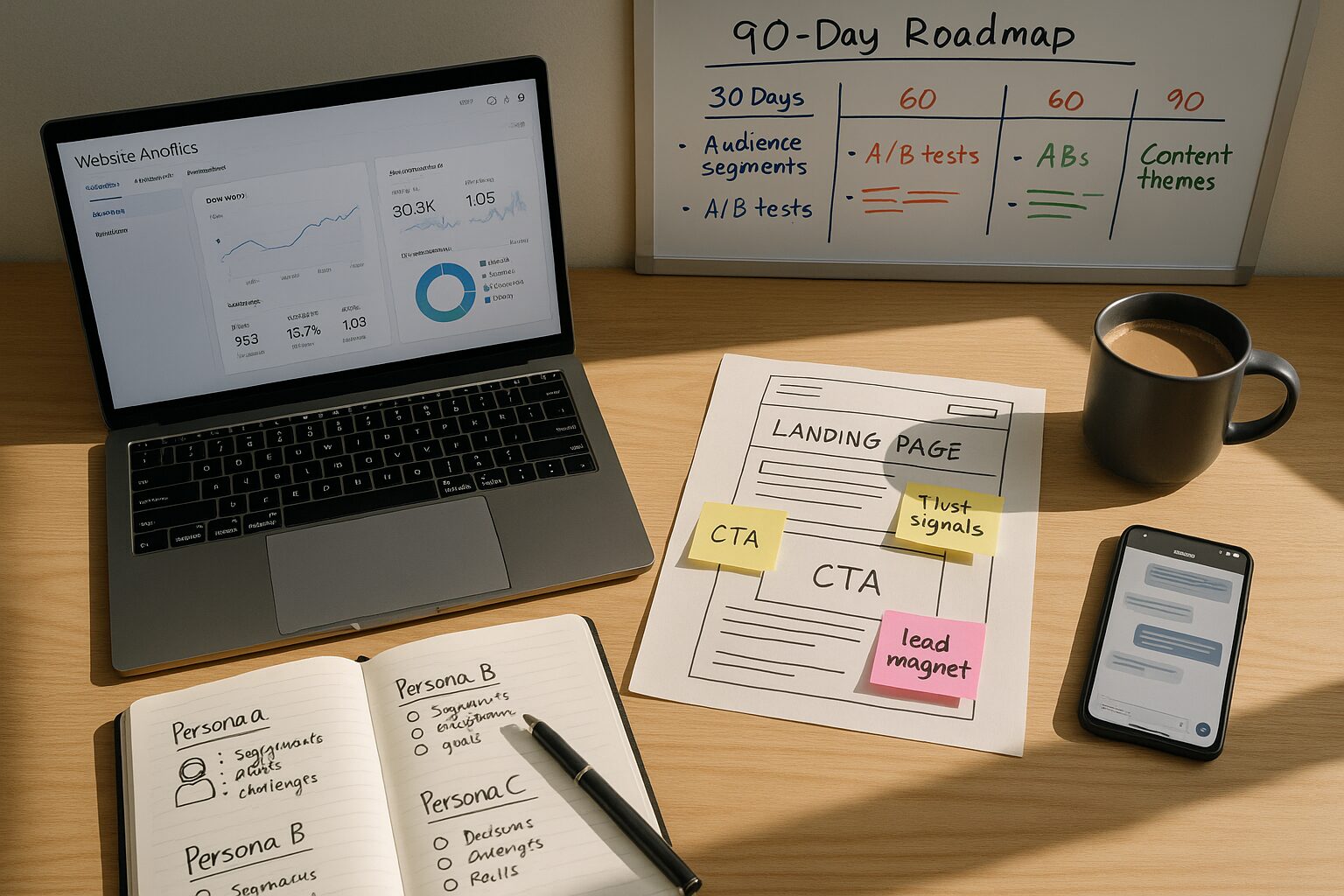Why website traffic alone isn’t enough
High volumes of website traffic are a good start, but they are not the same thing as new customers. Traffic measures interest; conversions measure value. Without a deliberate strategy to turn visitors into leads and customers, even the most impressive visitor numbers can have little impact on revenue.
Think of your website as a sales funnel: visitors enter at the top, but only a fraction will recognise a problem, understand your solution, trust your brand, and take action. Your job is to reduce friction at every stage of that journey so more visitors become paying customers.
Understand and segment your traffic
Begin by analysing where your visitors come from and what they do when they arrive. Use tools such as Google Analytics, server logs and your CRM to break traffic down by channel (organic, paid, referral, social), campaign, landing page and device.
Segmentation is essential. Different audiences have different intent—an organic blog reader may be researching, while a visitor from a product-price page is closer to purchase. Create segments such as new vs returning, high-intent pages, referral partners and paid audiences, then tailor messaging and offers to each group.
Optimise landing pages and user experience
Conversion rate optimisation begins on the page. Every landing page should communicate a clear value proposition above the fold, use concise headlines, and include a single, prominent call to action (CTA). Remove distractions that compete with the primary conversion goal.
Technical performance matters too. Ensure pages load quickly, display correctly on mobile, and have accessible forms. Add trust signals such as client logos, testimonials, security badges and case studies. Small UX improvements—reducing form fields, improving button contrast, simplifying navigation—often deliver outsized gains.
Content strategy that converts
Content should be designed to guide visitors along the buyer’s journey. Top‑of‑funnel content (how‑to guides, thought leadership) builds awareness. Middle‑of‑funnel content (comparison posts, webinars, case studies) builds consideration. Bottom‑of‑funnel pages (demo requests, pricing pages, product comparisons) drive purchase decisions.
If you need to scale content production, tools can help accelerate output. For example, services such as autoarticle.net offer automatic A.I. article generation for both WordPress and HubSpot blogs. Use such tools to produce drafts quickly, but always edit for accuracy, brand voice and SEO so the content genuinely serves your audience.
Capture leads and build a nurturing funnel
Converting visitors into customers usually requires capturing contact information and then nurturing that relationship. Offer high‑value lead magnets—whitepapers, templates, calculators or exclusive webinars—in exchange for an email address. Use clear, low‑friction forms and consider progressive profiling to gather more data over time.
Once captured, segment leads and automate nurturing sequences that match their needs and stage. Personalised email flows, product walkthroughs, targeted case studies and time-limited offers help move prospects through the funnel. Integrate lead capture with your CRM so sales teams can engage at the right moment.
Use experimentation and analytics to improve conversion
What converts varies by audience, industry and product. Implement a culture of testing: run A/B tests on headlines, CTAs, layouts and offers. Use multivariate tests for more complex pages and heatmaps and session recordings to observe visitor behaviour and identify friction points.
Track the right metrics: conversion rate by page and segment, cost per acquisition (CPA), average order value (AOV), lifetime value (LTV) and churn. Establish baseline metrics, set target improvements and measure the impact of every change you make.
Leverage retargeting and paid tactics wisely
Many visitors need multiple exposures before converting. Retargeting (display, social, paid search) lets you re‑engage people who visited but did not convert. Create ad creative that reflects the visitor’s intent—for example, show a product demo to visitors who viewed pricing or a case study to visitors who read a use-case article.
Paid acquisition should be aligned to lifetime value. Monitor CPA against LTV and prioritise channels and campaigns that deliver scalable, profitable customer acquisition. Use lookalike audiences and high‑quality landing pages to improve paid performance.
Practical 90‑day roadmap to turn traffic into customers
Day 1–14: Audit. Review analytics, identify high-traffic pages with low conversion and map audience segments. Implement quick technical fixes (page speed, mobile issues) and ensure analytics tagging is correct.
Day 15–45: Prioritise. Create a backlog of optimisations: landing page tweaks, lead magnets, CTA updates. Start one high‑value A/B test and set up retargeting for key pages. Produce a content plan aligned to buyer intent.
Day 46–90: Scale and automate. Roll out winning tests, expand content production, set up automated nurture sequences and integrate leads into your CRM. Monitor KPIs and iterate monthly. If you need faster article production, consider using tools like autoarticle.net to create draft posts you can refine and publish to WordPress or HubSpot.
Measure success and commit to continuous improvement
Conversion optimisation is continuous. Establish a dashboard that tracks conversions by channel, page and campaign, and review it weekly. Use cohort analysis to understand how customer behaviour changes over time and attribute value appropriately across marketing touchpoints.
Finally, foster cross‑functional collaboration between marketing, product and sales. The best improvements come from combining behavioural data, customer feedback and commercial priorities. By treating website traffic as the start of a relationship—not the end—you transform visits into reliable, repeatable customer acquisition.

